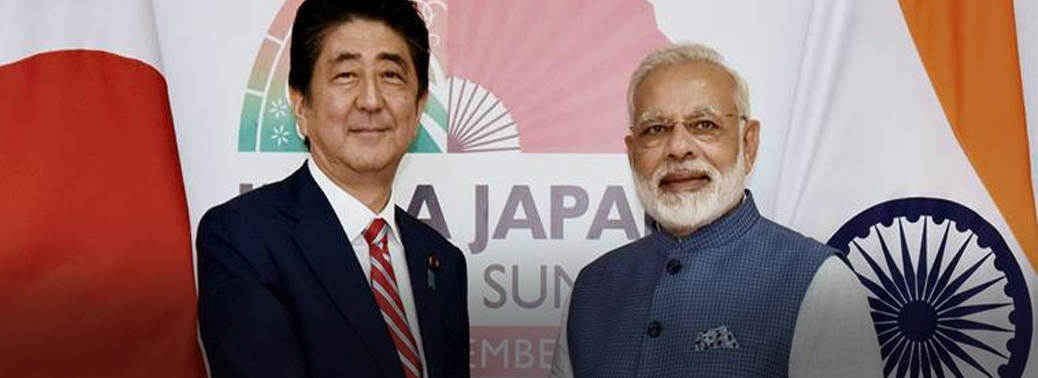MOU BETWEEN INDIA AND JAPAN
05, Sep 2018

Prelims level : Indian Economy Infrastructure – Railways
Mains level : GS Paper – III Infrastructure Railways.
Japan International Cooperation Agency has signed an agreement with India to provide an Official Development Assistance (ODA) Rs 5,500 Crore loan, as the first tranche for the Mumbai-Ahmedabad High-Speed Rail (MAHSR) corridor, popularly
known as the bullet train project and to Kolkata East-West Metro Project
Bullet Train:
- Japan International Cooperation Agency (JICA) today announced it has signed an agreement with India to provide an Official Development Assistance (ODA) loan of 89,547 million Japanese Yen (around Rs 5,500 Crore) for bullet train
- The objective of the project is to develop a high-frequency mass transportation system by constructing the High-Speed Rail between Mumbai and Ahmedabad, using Japan’s Shinkansen technology (also known as the “Bullet Train”), thereby enhancing mobility in India and contributing to regional economic
- The first high speed train is scheduled to leave for its first run on 15 August
- The system will be designed to operate trains at a maximum speed of 350 kilometres per hour while operational speed would be 320 kilometres per hour. When traveling at 350 kilometres per hour a train will be able to travel end-to-end on the 508 kilometres line in 2 hours and 8 minutes. Currently, a train journey from Mumbai to Ahmedabad takes 7 hours.
Japan’s Shinkansen Technology:
- The Japanese Shinkansen is the first high-speed rail system which started its commercial operation in 1964 between Tokyo and Osaka. The system has several criteria which include safety, reliability and sustainability in its
- It has a stellar reputation of zero fatalities recorded throughout 53 years of operation in Japan. The Shinkansen operates based on the “Crash Avoidance” principle, which dictates a design eliminating any possibility of a crash
- The “Crash Avoidance” principle comprises of a dedicated high-speed rail track free of any level crossings and the Automatic Train Control (ATC) system which reliably safeguards against crashes by preventing the train from running at excessive
- The Shinkansen system is also designed to withstand natural disasters and abnormal weather
- It also has in place the deviation prevention measures to prevent train cars from deviating off the track and colliding with incoming trains or structures in the event that a train does derail.
- In the tropical country, where rain is frequent, the control centre will constantly monitor data from rain gauges installed along the lines to enforce speed restrictions when the rain level exceeds a predetermined
- The train system is very reliable. It has recorded less than one-minute average delay time per trip, therefore, ensuring punctuality for
- India become the first nation to import the iconic Shinkansen bullet trains, which will be a highlight of India’s infrastructure upgrade program.
NHSRCL:
- National High-Speed Rail Corporation Limited is implementing the project of high-speed train corridor between Ahmedabad and
- This Special Purpose Vehicle has been incorporated in 2012 as a subsidiary of Rail Vikas Nigam Limited which is a Mini-Ratna public sector enterprise of Government of
Advantages:
- High-speed connectivity: India is a vast country and the need to travel faster has become a necessity. While air transport can cater to such needs, the capacity that it offers simply cannot match that of the railways. While making incremental changes to improve existing infrastructure is desirable, it is equally important to adopt proven state-of-the-art technologies. The High-Speed Railway Line will be effective in meeting this
- Apart from diverting passengers from road and air, Bullet train generates a new class of passengers as well. With the average operating speeds higher than 250 km/h, High Speed Railways will make the distance of 500 km reachable in two
- Less stress on the Railways: The conventional Indian Railways lags substantially in extending, accelerating and modernizing its infrastructure and services. There is a serious need to segregate its passenger business from freight. With advent of bullet trains the stress on the railways would be
- Employment: The bullet train project is expected to create 4,000 direct job opportunities, along with 20,000 indirect jobs. 20,000 construction workers will also be employed during the set-up period of Ahmedabad-Mumbai bullet
- Urban expansion: New bullet train stations set to come up along the route will attract urban growth. This will again shift the pressure of urbanization from the existing urban centres.
- Environmental: In the backdrop of increasing concerns over environmental pollution and degradation of fossil fuels, energy-efficient and environmentally friendly, high-speed electric trains emit an eighth and a fifth of carbon dioxide as against automobiles and airplanes per passenger km,
- Enhanced Safety: High Speed Railways’ safety record is remarkable. With a 2,500-km network, providing high frequency, up to 14 trains per hour, the Shinkansen/Bullet train ever since its inception has maintained a unique record of no fatal
- Other avenues: The prime purpose of Bullet trains in India to provide convenience to commuters. However, it can also make a difference in freight transportation. Be it courier mail services, perishables, or other items, any fast alternative to overloaded lorries should be welcome for businesses as well as private






